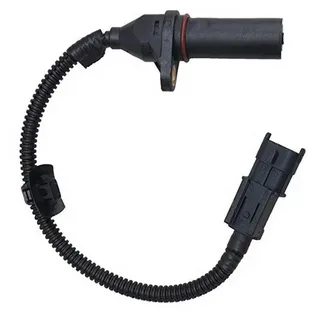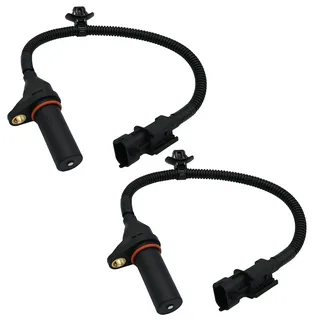Your Kia Rio is a reliable companion on the road, but what happens when it shows signs of trouble? The crankshaft position sensor is a critical component that plays a pivotal role in your engine’s performance. This small yet mighty device ensures everything runs smoothly under the hood. However, like any part, it’s not immune to wear and tear.
If you notice unusual behavior from your vehicle – such as stalling or poor acceleration – it might be time to delve deeper into understanding what’s happening with your Kia Rio Crank Sensor.
What Is a Crankshaft Position Sensor?
The crankshaft position sensor is a vital component of your Kia Rio’s engine management system. It monitors the crankshaft’s position and rotational speed, translating this information into signals that help control various engine functions.
Located near the crankshaft, the sensor uses magnetic or optical technology to detect when each cylinder fires. This data is crucial for precise timing in fuel injection and ignition processes. Without accurate readings from this sensor, your vehicle’s performance can suffer dramatically.
In modern vehicles like the Kia Rio, electronic control units (ECUs) rely heavily on data from multiple sensors, including the crankshaft position sensor. The ECU adjusts fuel flow and ignition timing to optimize power output while maintaining efficiency.
When functioning correctly, the crankshaft position sensor ensures smooth engine operation. However, if it fails or provides inaccurate readings, you may experience issues ranging from rough idling to stalling during acceleration.
It’s a small part with significant responsibilities; understanding its role helps you appreciate why monitoring its health is so important for overall vehicle performance.
The Role of the Crankshaft Position Sensor in Your Kia Rio
The crankshaft position sensor is vital to your Kia Rio’s engine management system. It monitors the crankshaft’s position and rotational speed, providing crucial data to the vehicle’s computer. This information is essential for optimizing fuel injection and ignition timing.
Accurate readings from the crank sensor ensure your engine runs smoothly and efficiently. When it sends signals to the Engine Control Unit (ECU), it helps maintain proper combustion within each cylinder. A well-functioning sensor promotes better performance, including improved acceleration and fuel economy.
This component enhances performance and supports emissions control systems in your Kia Rio. EnsuringEnsuring precise timingminimizes harmful exhaust emissions, contributing to a cleaner environment.
When issues arise with this sensor, they can lead to significant problems under the hood. Poor or erratic behaviour may cause misfires or stalls during operation, affecting overall drivability. Therefore, understanding its function can help you recognise when something might be going wrong.
Regular checks on various sensors are an integral part of vehicle maintenance. Monitoring your Kia Rio crankshaft position sensor will help prevent serious complications down the road while keeping your ride smooth and enjoyable.
 Common Symptoms of a Failing Crankshaft Position Sensor
Common Symptoms of a Failing Crankshaft Position Sensor
A failing crankshaft position sensor can lead to a range of noticeable symptoms in your Kia Rio. One of the first signs you might encounter is trouble starting the engine. You may find it cranks but fails to start, leaving you frustrated and stranded.
Another common symptom is irregular or erratic idling. When this sensor begins to fail, it can disrupt the air-fuel mixture, leading to an unstable idle that causes your vehicle to shake or vibrate unexpectedly. This could make driving uncomfortable and concerning.
You might also notice stalling while driving. If the engine suddenly cuts off without warning, it’s often linked to issues with the crankshaft position sensor. This not only poses safety risks but also adds stress during everyday commutes.
Decreased fuel efficiency can be another red flag. A malfunctioning sensor alters timing and combustion efficiency, resulting in higher fuel consumption than normal for your Kia Rio.
Keep an eye out for dashboard warning lights illuminating your instrument panel. The check engine light frequently activates when there’s a problem with the crankshaft position sensor, signalling that something needs attention immediately.
How a Faulty Sensor Affects Performance
A faulty crankshaft position sensor can lead to a cascade of performance issues for your Kia Rio. This essential component monitors the crankshaft’s position and speed, providing vital information to the engine control unit (ECU). When it malfunctions, this data becomes unreliable.
One immediate effect is difficulty starting your vehicle. You might find that your Kia struggles to turn over or takes several attempts before igniting. This frustrating scenario often leaves drivers feeling helpless on chilly mornings.
Acceleration problems are another common symptom. A malfunctioning sensor can cause erratic throttle response, making it difficult to pick up speed smoothly when merging onto highways or navigating busy streets. The last thing you want is an unresponsive car in critical moments.
Engine stalling may also occur randomly without warning. If your Kia Rio suddenly loses power while driving, it’s likely due to inaccurate readings from the crankshaft position sensor affecting fuel delivery and ignition timing.
Poor fuel efficiency could be a silent yet significant consequence of a failing sensor. As the ECU scrambles to compensate for incorrect data, your engine may consume more fuel than necessary, leading to bigger gas bills and negative environmental factors.
Diagnosing Crankshaft Position Sensor Issues
Diagnosing crankshaft position sensor issues can be straightforward if you know what to look for. Begin by observing your Kia Rio’s performance. Common signs of trouble include hard starting, poor acceleration, and stalling. If you experience these symptoms consistently, it may indicate that the crank sensor is failing.
Next, check for any warning lights on your dashboard. The check engine light often illuminates when there’s a problem with the crankshaft position sensor or related systems. A diagnostic scan tool can read error codes stored in the vehicle’s computer, providing valuable insights into potential issues.
Visual inspection is another crucial step. Inspect the wiring and connectors leading to the sensor for any visible damage or corrosion. Sometimes loose connections can lead to erratic behavior or failure altogether.
If everything appears normal externally, consider using a multimeter to test resistance levels at different points within the circuit. This method allows you to determine whether the sensor itself is functioning properly.
Consult professional diagnostic services if needed; they have specialized equipment and expertise that may pinpoint problems more quickly than DIY methods alone can achieve.
How to Test the Crankshaft Position Sensor
Locating the Crankshaft Position Sensor
To begin testing the crankshaft position sensor in your Kia Rio, locate the sensor, typically found near the engine block’s lower part or close to the flywheel. Having a multimeter ready is essential for the testing process.
Testing Sensor Continuity
Start by checking the sensor’s continuity. Disconnect the electrical connector and set the multimeter to measure resistance. Place one probe on each terminal of the sensor. A reading within a specified range indicates proper functionality, while no reading suggests the sensor may be faulty.
Checking Voltage Output During Cranking
Reconnect the sensor and set the multimeter to AC voltage. Crank the engine while observing for an alternating current signal. The presence of this signal indicates the sensor is detecting crankshaft movement correctly. If no voltage is detected, this could point to a sensor malfunction or wiring issues.
Repair or Replacement Options
You have several options when faced with a failing Kia Rio crank sensor. Repairing the sensor is sometimes feasible if it’s not completely malfunctioning. A skilled mechanic may be able to recalibrate or clean it, restoring functionality without needing a full replacement.
However, often the most reliable choice is replacing the faulty sensor altogether. This ensures that your vehicle operates at peak performance and minimizes further issues. While this option might involve more upfront costs, it’s an investment in your car’s reliability.
If you choose to replace the crankshaft position sensor yourself, ensure you source quality parts from reputable suppliers. High-quality sensors can last longer and improve engine efficiency compared to cheaper alternatives that may fail sooner than expected.
For those who prefer professional help, many repair shops offer competitive pricing for both parts and labour. It’s wise to obtain quotes from multiple mechanics before deciding where to go for repairs or replacements.
Always document any repairs performed on your Kia Rio crank sensor. This information can be invaluable when troubleshooting future issues or maintaining resale value should you decide to sell your vehicle later.
Preventive Maintenance Tips of Kia Rio Crankshaft Sensor
Taking care of your Kia Rio Crankshaft Sensor ensures that all components, including the crankshaft position sensor, function effectively. Regular maintenance is key to preventing unexpected issues.
Start by checking engine codes with an OBD-II scanner. This tool can help you catch issues with your Kia Rio crank sensor early on. If any trouble codes pop up, address them promptly.
Next, monitor fluid levels and quality. Engine oil should be clean and at the proper level for optimal performance. Dirty or low oil can stress various engine components, including sensors.
Also, regularly inspect the wiring and connectors around the crankshaft position sensor. Look for frays or corrosion that could lead to faulty readings or complete failure of the Kia Rio Crankshaft Sensor.
Schedule routine check-ups with a trusted mechanic who understands Kia vehicles. They will provide valuable insights into potential problems before they escalate into costly repairs. Staying proactive can save you both time and money in the long run while keeping your car running smoothly.
Conclusion
Understanding the importance of your Kia Rio crank sensor is vital for maintaining optimal vehicle performance. A failing crankshaft position sensor can lead to significant issues that affect both drivability and engine efficiency.
Awareness of common symptoms—such as stalling, difficulty starting, or poor acceleration—can help you catch problems early on. If you notice any irregularities in your car’s performance, it’s essential to address them promptly.
Regular maintenance is crucial in preventing crank sensor failure. Simple checks during routine service can save you from more costly repairs. Keeping an eye on warning lights and listening to unusual sounds will serve you well.
FAQs
What does a crankshaft position sensor do?
The crankshaft position sensor monitors the crankshaft’s position and rotational speed. This information is vital for optimal engine timing and fuel injection control.
What are common signs of a failing Kia Rio crank sensor?
Common symptoms include poor acceleration, stalling, rough idling, or trouble starting. You might also notice an illuminated check engine light on your dashboard.
Can I drive my car with a faulty crankshaft position sensor?
While driving with a malfunctioning sensor is possible, doing so is not advisable. It could lead to further damage or a complete breakdown of the vehicle.
How do I diagnose problems with my Kia Rio’s crankshaft position sensor?
A professional diagnostic tool can read your vehicle’s computer system error codes. These codes will help pinpoint whether the issue lies with the crank sensor or another component.
| Other Good Articles to Read |
| Skank Blogs |
| Unreal Blogs |
| Tba Blogs |
| All City Forums |
| Dany Blogs |
| Refuge Blogs |
| The Music Blogs |
| Key Forums |
| The Big Blog Theory |
| Joe Blogs |
| Blogs 4 Me |
| Blogs Emon |
| Related Business Listings |
| Contact Directory |
| Local Business Profiles |

